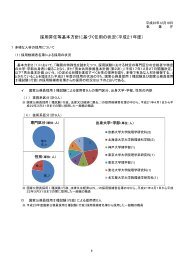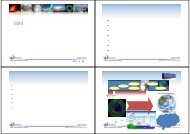Chapter 5 Measurement of Atmospheric Pressure
Chapter 5 Measurement of Atmospheric Pressure
Chapter 5 Measurement of Atmospheric Pressure
You also want an ePaper? Increase the reach of your titles
YUMPU automatically turns print PDFs into web optimized ePapers that Google loves.
the gasket with a pair <strong>of</strong> tweezers and immerse it into the beaker filled with filtered mercury toallow the mercury to adsorb the dirt. Then attach the gaskets during reassembly.(5) Filtering mercury and cleaning componentsFor the filtering the mercury, pour the mercury into the strain that stands on a beaker coveredby a thick paper (cross grained paper) (See Figure 5.17).First, filter mercury with a rough strain, then again with a fine strain. Repeat this twiceor more until no dust is found. Since this process requires a lot <strong>of</strong> time, this filtering workshould start as soon as the mercury is drained into the beaker.Wipe the glass cylinder with cleaning paper moistened with alcohol, being careful not torub <strong>of</strong>f the marks. Scrape <strong>of</strong>f excess dirt with a cutter, taking care not to damage the glasscylinder, then polish the surface with a toothbrush and toothpaste. Wipe the glass cylindersufficiently to remove moisture.Wipe the boxwood part (Figure 5.16, c) with the cleaning paper. Wipe the inside <strong>of</strong> thewash-leather bag (Figure 5.12, b) with the cleaning paper. Then, put single-filtered mercuryinto the bag up to about 1/3, hold the bag with one hand to prevent mercury from splashing,and rub it with another hand to allow the mercury to adsorb the dirt. Repeat this process untilthe dirt in the bag is not found.Filter the contaminated mercury again and repeat it until it becomes clean.Wipe dust <strong>of</strong>f the ivory pointer with a brush and the paper s<strong>of</strong>tly. Take care not tomove or damage the ivory pointer, as it will affect index error. Wipe dust <strong>of</strong>f the woodenframe and glass tube with a brush and the cleaning paper.Some barometers contain mica plates (Figure 5.2, 22) inside the brass cylinders (Figure5.2, 21). Remove the mica plates carefully and wipe dust <strong>of</strong>f with the cleaning paper or abrush.Bubbles <strong>of</strong>ten cling to the inlet <strong>of</strong> the glass tube. Pull them out by inserting awell-dried iron wire (such as a needle).(6) Assembling the mercury cistern glass cylinderReassemble the glass cylinder in the reverse order <strong>of</strong> disassembly. Before reassembly, wipedust <strong>of</strong>f with clean paper or brush very carefully.Hold the upper and lower parts <strong>of</strong> the glass tube, assemble it to the main body. Becareful not to mix up the upper and lower sides and its orientation or leave fingerprints.When the gasket comes <strong>of</strong>f, s<strong>of</strong>ten and wash it well with mercury before setting it into thegroove.Place the boxwood (Figure 5.16) on the main body and cover it with the brass metal frame(Figure 5.16), paying careful attention to the marks and the gaskets.Attach the three screws (Figure 5.16) to the original positions. Tighten the screwswhile rotating the main body and adjusting the balance <strong>of</strong> screws to each other. Unbalancedtightening may result in mercury leakage or glass tube breakage.To clean the assembled mercury cistern (Figure 5.15), pour mercury through theclearance <strong>of</strong> the wooden base while filtering so that the mercury adsorbs dirt. To drain themercury, plug the opening <strong>of</strong> the tube (Figure 5.15, b) with a fingertip covered with afingerstall and turn the main body upside down. If this is done when the mercury is concave19






![関東地方の「紅葉の見ごろ予想」[PDF形式:250KB] - 気象庁](https://img.yumpu.com/47747063/1/184x260/pdf250kb-.jpg?quality=85)

![雨に関する各市町村の50年に一度の値一覧[PDF形式:417KB] - 気象庁](https://img.yumpu.com/47450161/1/190x134/50pdf417kb-.jpg?quality=85)
![1か月予報[九州北部地方]解説資料](https://img.yumpu.com/47153516/1/184x260/1.jpg?quality=85)
![職員募集案内パンフレット[PDF形式:約9MB] - 気象庁](https://img.yumpu.com/45714300/1/184x260/pdf9mb-.jpg?quality=85)


![ダウンロードファイル[PDF形式: 約15MB] - 気象庁](https://img.yumpu.com/43657928/1/190x135/pdf-15mb-.jpg?quality=85)


